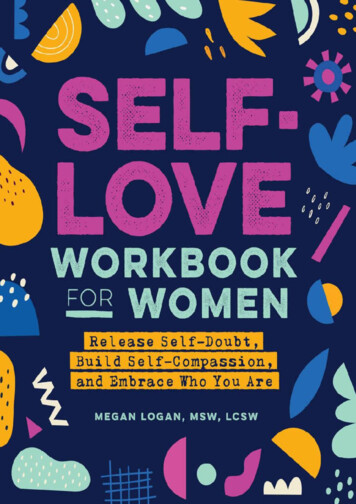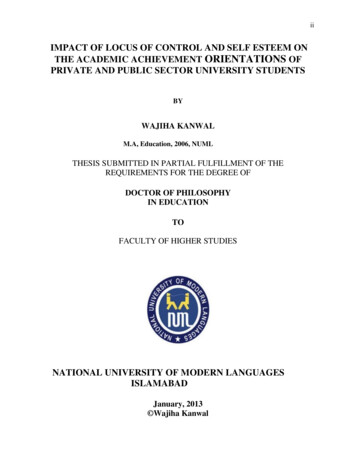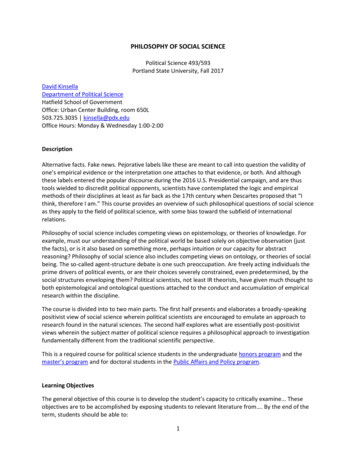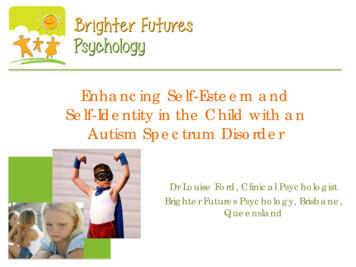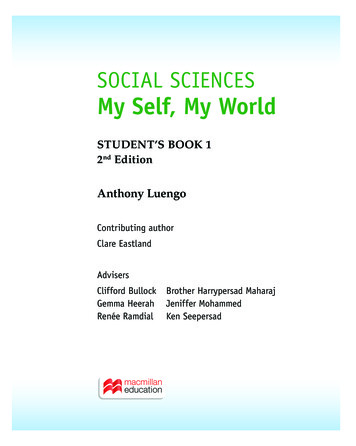
Transcription
Unit 3 Sample TextSOCIAL SCIENCESMy Self, My WorldSTUDENT’S BOOK 12 nd EditionAnthony LuengoContributing authorClare EastlandAdvisersClifford BullockGemma HeerahRenée Ramdial9780230447196 text.indd 1Brother Harrypersad MaharajJeniffer MohammedKen Seepersad09/03/2016 16:58
Macmillan Education4 Crinan StreetLondon, N1 9XWA division of Macmillan Publishers LimitedCompanies and representatives throughout the worldISBN 978-1-380-02548-7Text Anthony Luengo 2008, 2015Additional material by Clare EastlandDesign and illustration Macmillan Publishers Limited 2008, 2015The author has asserted his rights to be identified as the author of thiswork in accordance with the Copyright, Designs and Patents Act 1988.First published 2008All rights reserved; no part of this publication may be reproduced, storedin a retrieval system, transmitted in any form, or by any means, electronic,mechanical, photocopying, recording, or otherwise, without the priorwritten permission of the publishers.Original design by Alex TuckerPage make-up and typesetting by Red GiraffeIllustrated by Peter Bull Art Studio, Red Giraffe, Tek-Art and Gary WingCover design by Macmillan EducationCover photograph Alamy/agefotostockPicture research by Catherine DunnThe author and publishers would like to thank the following forpermission to reproduce their photographs:Alamy/Adams Picture Library t/a apl p250(br), Alamy/amana images inc.p141(cr), Alamy/Art Directors & TRIP pp144(c), 171, 211, 216, Alamy/Johnde la Bastide p132(b), Alamy/Henry Beeker p225(tr), Alamy/Judy Bellahp212(c), Alamy/Biju p19, Alamy/Blend Images pp30, 83, 223, Alamy/blickwinkel pp140(tr), 152(l), Alamy/Steve Bly p77(br), Alamy/Caribbeanp247(tr), Alamy/Robin Chittenden p218, Alamy/dbimages pp138(cr), 146(tr),Alamy/Design Pics Inc. p55, Alamy/Dinodia Photos p53, Alamy/RobertDown p195, Alamy/epa european pressphoto agency b.v. p15, Alamy/FLPA p214(br), Alamy/Carole Anne Ferris pp2, 156(cr), Alamy/FLPA p221,Alamy/Findlay p252, Alamy/Gallo Images p128(br), Alamy/Bob Gibbonsp214(cr), Alamy/Mark Gibson p4(br), Alamy/Heritage Image PartnershipLtd p6, Alamy/Hero Images Inc. p115, Alamy/Image Source p54(bl),Alamy/LOOK Die Bildagentur der Fotografen GmbH pp215(tr), 243,Alamy/Mart of Images p62(tl), Alamy/MBI p63, Alamy/MJ Photographypp139(tr), 170(tr), Alamy/McClatchy-Tribune Information Services p95(tr),Alamy/North Wind Picture Archive p108, Alamy/Altin Osmanaj p212(b),Alamy/PhotosIndia.com LLC p91, Alamy/Samantha Nundy p42, Alamy/M. Timothy O’Keefe p140(br), Alamy/RF Company p109(cr), Alamy/Kevin Schafer p241, Alamy/Stocktrek Images Inc p236(cr), Alamy/MarkSummerfield p132(t), Alamy/tbkmedia.de p215(bl), Alamy/Simon TranterPhotography p118, Alamy/Tommy Trenchard p124, Alamy/Mireille Vautierp220(tr), Alamy/World History Archive p4(bl), Alamy/WORLDWIDEphoto p146(tl); Art Directors & TRIPP/Alamy pp114, 135(t), Art Directorsand TRIPP/Helene Rogers p95(cr), Art Directors & TRIPP/Bob Turner p213(tr);BRAND X PICTURES p176(br); Stephen Broadbridge pp102, 225(br);Corbis pp165, 239, Corbis/Christophe Boisvieux p177, Corbis/HBSS9780230447196 text.indd 2p64(tl), Corbis/FACUNDO ARRIZABALAGA p125, Corbis/Christie’sImages p253, Corbis/PETER COOK/VIEW p238, Corbis/Ashley Cooperp242(br), Corbis/Laura Doss p88(tr), Corbis/Mahmoud illean/Demotixp121(t), Corbis/Jack Hollingsworth p281, Corbis/Deborah Jaffe p88(tl),Corbis/Bob Krist p86, Corbis/Julian Kumar p154(tr, br), Corbis/RolfRichardson p100(tr), Corbis/Martin Rietze p236(cr), Corbis/ANDREADE SILVA pp72, 123, 133, 147(br), 152(tr), 156(br), 206, 207 234, Corbis/Kurt Stier p176(bl), Corbis/STRINGER/Reuters p120, Corbis/DavidZentz/Aurora Photos p220(cr); Ray Cunningham p169(bl); Clare Eastlandpp170(bl), 237; Ellie Mannette’s Collection p77(tr); Fotolibra/Tim Gartsidep220(br), Fotolibra/SYLVIE DE LEU p128(tc), Fotolibra/Christine Nortonp147(tr), Fotolibra/Peter Phipp p215(br); Getty Images pp249, Getty/AFP/ ARIS MESSINIS p111, Getty/Gonzalo Azumendi p159, Getty/Arvind Balaraman p128(bl), Getty/Subir Basak p137, Getty/WalterBibikow p247(tl), Getty/ Hamish Blair – GCV p17, Getty/Ian Brierleypp135(b), 144(c), Getty/Demetrio Carrasco p213(cr), Getty/Donald,Michael Chambers pp81, 109(br), Getty/Amos Chapple p166, Getty/commerceandculturestock p74(bl), Getty/Dorling Kindersley p119,Getty/ Sean Drakes p156(br), Getty/elkor p143, Getty/Lori Epsteinp176(tr), Getty/ERproductions Ltd p75(cr), Getty/Stuart Fox p95(tr),Getty/Fuse p32, Getty Images/ICC p75(tcr), Getty/Erik Isakson p75(tr),Getty/Silvia Jansen p128(tr), Getty Images/Wolfgang Kaehler p139(br),Getty/Lucille Kanzawa p206, Getty/LatinContent p147(bl), Getty/Leemage p175, Getty/Darryl Leniuk p242(tr), Getty/Meriel Lland p213(br),Getty/John Lund p74, Getty/Hemant Mehta p109(c), Getty/MichaelMelford p215(cr), Getty/Pramod R. Mistry p176(br), Getty/Peter Mullerp84, Getty/New York Daily News Archive p1, Getty/WYSOCKI Pawelp235, Getty/Marc Shandro p167, Getty/ Jeneil Singh p138(tr), Getty/Robin Smith p106(t), Getty/Justin Sullivan p201, Getty/Wail ShaifThabet/Anadolu Agency p122, Getty/Visage ppv,128(bc), Getty/JIMWATSON p258, Getty/NI QIN p128(tl), Anthony Luengo p170(tl); MarkLyndersay pp169(br), 210; Macmillan Publishers Ltd pp170(bl), 237, 287,Macmillan Publishers Ltd/ Faraz Abdool p20, Macmillan Publishers Ltd/Rob Judges pp54(br), 104, 105, Macmillan Publishers Ltd/Devon Shawp3, Macmillan Publishers Ltd/Alex Smailes p141(tr); Mary Evans PictureLibrary p140(t), Mary Evans picture Library/The Everett Collection p106(b),Mary Evans Picture Library/Peter Higginbotham Collection p250(tr);NPG/Richard Beard p66; Paria Publishing p138(br); Press Association/Andres Leighton p257; Kenrick Rampial - Silverpin Design Co Ltd.pp139(tl, bl); Rex/Gail Orenstein/NurPhoto p121(b); Robert HardingWorld Imagery/Eye Ubiquitous/ p64(tr), Robert Harding/Glow Imagesp100(tl); Science Photo Library p200, Science Photo Library/CORDELIAMOLLOY p202; Hugh Stickney p139(cr); Superstock/martino motti/Marka p97; Thinkstock/dima266f p174, Thinkstock/Georgios Kollidasp160, Thinkstock/poco bw p152(br), Thinkstock/Ariel Skelley p62(tl);Triniview pp139(cl), 217.These materials may contain links for third party websites. We have nocontrol over, and are not responsible for, the contents of such third partywebsites. Please use care when accessing them.Printed and bound in Europe2020 2019 2018 2017 201610 9 8 7 6 5 4 3 209/03/2016 16:58
ContentsTo the studentScope and sequenceIntroductionStudying social sciencesSocial sciences and humanities subjectsWhat is social studies?What is geography?What is history?What is religious education?Unit 1 Personal developmentChapter 1 Who am I?1.11.21.3Personal identityPersonality and individual differencesDeveloping a positive self-image andself-esteemivvi11336912132022Chapter 2 Where do I belong?2.12.22.32.42.52.62.727What is a family?27Functions of the family30Family customs and traditions34Family history35Family trees35Roles and responsibilities of family members 37Conflict in the home, school andneighbourhood41Chapter 3 How am I changing?3.13.23.33.43.5Life cycleChildhoodAdolescenceAdulthoodMy personal historyUnit 2 Economic growth and developmentChapter 4 Developing our human resources4.14.24.34.44.54.64.74.8What are resources?Studying our populationCharacteristics of human resourcesFactors that influence our human resourcesThe importance of human resources foreconomic developmentThe role of education in the developmentof human resourcesThe history of secondary education inTrinidad and TobagoThe importance of health to humanresourcesUnit 3 How we govern ourselvesChapter 5 Living by the rules5.15.25.35.4Why do we have rules?Why do we have rewards and sanctions?Making rules in the home, school andother social groupsHow rules for the nation (laws) are r 6 Civic responsibilities, rights and freedoms 1046.16.26.36.49780230447196 text.indd 3My rights and responsibilities as a studentFundamental rights and freedomsBecoming a citizen of Trinidad and TobagoEntitlements of citizenship – our rightsand freedoms1041051101116.56.6Obligations or duties of citizenship –civic responsibilitiesCommunity involvement and serviceChapter 7 Humanitarian law7.17.27.37.47.5International treatiesInternational lawHumanitarian lawThe effects of warHumanitarian actsUnit 4 Our cultural heritage and religionChapter 8 Celebrating our culture8.18.28.38.4Our multi-cultural societyOur ancestorsOur cultural heritageConserving our cultural heritageChapter 9 Major world religions9.19.29.39.49.59.69.7IntroductionBelief systemsBrief background historiesImpact on the development of civilisationPlaces of worship in Trinidad and TobagoReligious symbolsReligion and the artsUnit 5 Our physical environmentChapter 10 Mapping our environment10.110.210.310.410.510.6Globes and mapsTypes of mapUses of mapsBasic features of mapsBuilding map skillsMaps of todayChapter 11 Our natural environment and tural resourcesFossil fuels and mineral resourcesWaterLandVegetationAnimalsAir, wind and sunlightThe consequences of using our naturalresources11.9 Caring for the environment11.10 Places and our environmentChapter 12 Caribbean geography, integration andglobal links12.112.212.312.412.512.6Where exactly is the Caribbean Region?The Commonwealth CaribbeanWhy the Caribbean is a regionThe Caribbean SeaCommon history of the Caribbean RegionCaribbean Integration lls toolkitSocial and interpersonal skills 261Communication skills 264Information-processing skills 269Enquiry and research skills 282Glossary290iii09/03/2016 16:58
To the studentUnit 1 Personal developmentWelcome to Student’s Book 1. You’ll find many opportunities in these pages to think creatively and critically aboutwhat it means to be a fulfilled individual in your own community and in our increasingly globalised world. Thisbook is part of a three-book course for Forms 1, 2 and 3 for students studying for the secondary NCSC and NCSEexaminations.1Now,acquaintyourself with the many features that will make your experience of working with this text anWhoam I?enjoyable and rewarding one.Key wordsKey questions toTheattitudesmain narrativebehaviourbody imagecharacteristicsemotionsemotional selfenvironmentethicsThegenesmain narrativeis the main storylineIt’s the textgoalsheredity of this book.high self-esteemthatidealtakesof the pages.It providesself up the centralindividualpart of mostindividualindividualitydifferencesyou with the background and essentialinformation that you needintellectualselfself-esteemmental selfto understand the main topics in loweachof the chapters.personal identity personalityphysical selfself-awarenessMost of this book relates to the Social Sciences curriculum, butself-esteemself-imagesocialsocial selfsome sections which specifically environmentrelate to other subject areas areflaggedup and colour-coded.Historysections arevaluesorangey brown,toleranceuniquevalue systemGeography sections are green and RE sections are blue.If someone asked you, ‘Who are you?’ you would probably givethat person your name. You might state just your first name.This name may be one that you share with others in your schoolor the wider community, and it may have a special meaning.For example, the name ‘Audrey’ means noble strength, while thename ‘Rajan’ means king. Is there a special meaning attached toKeywordsyourfirst name? If so, does it mean anything to you personally?Sometimes, people even change their names. Why do you thinktheywoulddo so?Keywordsappearat the beginning of each chapter. They are listsUnit 1 Personal developmentTrystartthis!thinking about} What makes me who I am?Try this! boxes help you to get} What makes me a uniqueactiveas you read. Through themindividual?youcanbecome creative with} How do I develop self-respectwhatyou’reSome haveand a positivelearning.view of myself?aquickquizormatchingexercise;} How can I respect andsomeincludeanopportunitytoappreciate others?create your own collages andposters, or to perform skits withyour classmates; some have ideasforTry‘hotthis!seat’ discussions. Try this!Choose one regulation atyour school. What rewards orsanctions are used to enforce it?Are they effective? Can you thinkof any better ways of ensuringthat the regulation is followed?Do a quick survey of members ofyour class. How many know whattheir first names mean and whythey were given their names?Did you know?Did you know? boxes have interesting related facts like this inthe margins of every chapter. They will make you look at thingsRaj, have youseen thatof importanttermsyourandfamilyideas thatshownin boldyouin the chapter.If you also statenameare(yoursurname),afresh,often from a different angle.movie I told you eyouwould be connecting yourself to people who are relatedto you,usuallyby blood.Together,first nameandgrasp ofunderstandwhatmean.They areyouressentialto yourWhoamI? theyDid you know?surnameare an isimportantwhatthe chapterabout. part of your personal identity.1They help to identify who you are, both as an individual –Political boundaries are just one way of defining or identifying aKey questions toKeywords in your own right – and as a member of a closelya personcountry. Other ways include national emblems, such as flags,start thinking aboutattitudesbehaviourbody imageconnected groupsuch as yourfamily. characteristicsnational anthems and coats of arms, national flowers and otheremotionsemotional selfenvironmentethicsI am?} What makes me whosymbols,systems of government, and national festivals such asIn some cultures,the Chinese, familynames precedegenesgoals such as heredityhigh self-esteem} What makes me a uniqueCarnival. You can use atlases or internet research to identify theidealself personalindividualindividualityothernames. Forindividualexample, someonewhom weindividual?national emblems of different Caribbean countries.differenceswould address in Trinidadand Tobago as Hui Fung would} How do I develop self-respectintellectualselflow self-esteemmental selfNot yet, Sandra.identify himself in China as Fung Hui. When people from and a positive view of myself?personal identity personalityphysical selfself-awarenesssuch cultures emigrate, however, they usually place their } HowEachcan I ofrespectanda name and a personalushasself-esteemself-imagesocialsocial selfothers?family names second. Somepeople (such as the Tuareg in appreciateenvironmentidentity.Untitled-5 1Africa) traditionallydid nottoleranceuniquevalueevensystemuse familyvaluesnames. Why doCheckpointsyou think this was so?21LONG PAGEIf someone asked you, ‘Who are you?’ you would probably givethat personyour name.toYoustartmight statejust your firstname.KeyquestionsthinkingaboutThis name may be one that you share with others in your schoolor the wider community, and it may have a special meaning.Keyquestionsto startthinkingaboutFor example,the name‘Audrey’means noblestrength, while thenamemeans king. Ismeaning attached toareat‘Rajan’the beginningofthereeacha specialchapter.your first name? If so, does it mean anything to you personally?Thesequestions are there to help youSometimes, people even change their names. Why do you thinkstartto focuson the key ideas in thethey woulddo so?chapterwithIf you alsoandstatehowyour theyfamilyconnectname (yoursurname), youyourexperiencesandyouare relatedwouldownbe connectingyourselfto thingspeople whoto you,usuallyby blood. Together, your first name andmayknowalready.Checkpoints encourage you to pause and make sure you Try this! understand what you’ve just read in the main narrative.Do a quick survey of members ofyour class. How many know whattheir first names mean and whythey were given their names?Checkpoint 1 Why do we have rules ofdifferent kinds for differentsituations?2 What are sanctions?3 What are the four mainRaj, have you seen thatmovie I told you about?purposes of punishment?surname are an important part of your personal identity.They help to identify who you are, both as an individual –a person in your own right – and as a member of a closelyconnected group such as your family.ivIn some cultures, such as the Chinese, family names precedeother personal names. For example, someone whom wewould address in Trinidad and Tobago as Hui Fung wouldidentify himself in China as Fung Hui. When people from9780230447196 text.indd 4such cultures emigrate, however, they usually place theirfamily names second. Some people (such as the Tuareg inNot yet, Sandra.Each of us has a name and a personalidentity.09/03/2016 16:58
To the studentThinking creatively and criticallyVisualsThinking creatively and critically boxes occur two or three timesin each chapter. They give you a chance to involve yourself increative and thought-provoking activities – on your own, with apartner or small group, or with your whole class. Activities includeanalysing television shows and films, writing short reports,interviewing members of your local community, delivering shortspeeches and creating classroom displays.Visuals are an important part of this book because you learnby seeing as well as by reading. Every chapter has many visualsrelated to the topics being discussed.Thinking creatively and critically1 Research the origins of the people in your community. Use primary sources(e.g. interviews, questionnaires) and secondary sources (e.g. books, theinternet). Present your research as a short article to appear in a newspaper andinclude one or more suitable visual aids. Also, write a headline that will capturethe attention of readers. See Skills toolkit ‘Enquiry and researchskills’ (page 282) and ‘Understanding and creating photographs’(page 281).234Interview someone who has come to Trinidad and Tobago as a migrant,and find out their reasons for coming here. Present your interviewas a dialogue. See Skills toolkit ‘Formatting a script’ (page 270).Create a timeline showing important events in the history anddevelopment of your community. Display your timeline in class.See Skills toolkit ‘Timelines’ (page 272).Write a fictional account of the arrival of an early settler or group of settlers inyour community that helps explain where they and their ancestors came fromand why they came to your community.Wrap-up activitiesWrap-up activities are activities and projects at the end of eachchapter to help you pull together all that you’ve learned in theWrap-up activitieschapter.1With a partner, interview one adult to collectinformation about their knowledge, skills,energy and creativity. Ask them about theirtalents, abilities, education, qualificationsand health. You could also ask about theirattitudes to work. Present a report on theperson as an example of our country’shuman resources.2Untitled-6 1Work with a group of four or five. Imaginethat you are creating a Carnival band onthe theme of human resources. Prepare anoral presentation for your class in whichyou introduce and describe your band. YourReviewsare found at the end of each chapter. Each provides youpresentation should answer questions suchwithas atheconvenientfollowing: summary of what the chapter has covered. What is the exact name of your band? Whywill this name grab the public’s attention?Revieware the band’s main sections? WhatWhatyou now knowWhat will the costumes in each section TrinidadTobagoroughis a signatoryof manydifferent international treatiesportray?and(Providesketches,ifconcerning human rights.possible.) International law is law which governs relations between countries or nations.What will your King of the Band portray? Countries to war to impose their rule on others or to defend themselves and(Provide goroughsketches, if possible.)their interests against others.Whatwillyourof the Band Humanitarian lawQueen is a set of rules which provides protection for those d conflicttries to iflimit its effects by restricting thepossible.)methodsof warfare (e.g. by banning indiscriminate weapons and childBe soldiers).prepared to answer questions from theclass. TheGeneva Conventions are the main humanitarian laws which set out theReviewrules for armed conflict. The experiences of those people affected by war include personal injury,disablement and psychological trauma. Humanitarian acts are actions by ordinary citizens or organisations to protectlife and human dignity. They often involve people in protecting someone theydo not know, or whom they would not ordinarily protect and may involvepersonal risk, loss, or long-term commitment.Untitled-81 Organisations known for humanitarian work includethe InternationalRedCross and Red Crescent, The Peace Corps, the UN Peacekeeping Force andMédecins sans frontières.9780230447196 text.indd 5TocoMaracasMacqueripe 01020 kmTRINIDADScale 1 : 1 094 000NWWGuayaguayareSipariaNEMayaroEMorugaSWIndus ValleyCivilisation – before2000 BC2000 BCSEpic, Puranicand Classical Age –500 BC–AD 5002000 1500BCE BC1000 BC500 BC0SEPre-modern IndependentPeriod –India –1500–1757 1947 – presentSkills tool kitAD 500Field (personal) observationVedicPeriod –1500–500 BCAD 1000MedievalPeriod –500–1500AD 1500AD 2000BritishPeriod –1757–1947Collecting information often begins with field, or personal,observation. This is taking note of what you see as you go aboutyour daily life or what you can see of your local environment.You may notice, for example, that a nearby river is brown withmud after a heavy rainfall, or that people in your neighbourhoodgather in groups at a particular street corner to chat in the earlyInternetboxes contain a URL that will take you to a website irect observationlike thiscan beinterestinghelpful in identifyingissuessuch as the effects of deteriorating buildings and problems ofgraffitiyourneighbourhood.It is veryuseful forstudyingYoucan inseea videoabout Jamaicanmigrantsin the1950sprocesses such as what happens in a factory, or how mothers reararrivingby ship at Southampton, in the United Kingdom at:their children, or events such as religious ceremonies. It can alsobit.ly/1tpRtl8be used when studying, for example, the condition of trees orother vegetation found in your local natural environment.It is important to record your observations as accurately andas immediately as possible. Methods of recording includesketches, sketch maps and taking photos. Tally sheets can beuseful for recording the number of times something occurs (e.g.of vehiclea particularstretch –289isroadfilledwith essentialrush hour). To make a tally count, you draw a short line for eachpracticaltipsforoccurrences,building thenthe putimportantskillsthat you’ll needoccurrencefor foura line throughthe fouroccurrencenumberfive. Thismakes itto add and,up the later, for CSEC andto forsucceedbothin andoutsideofeasyschooltotal number in groups of five. Checklists can be useful to tick offCAPEexams.Forexample:to workeffectivelythingsseen (e.g.differenttypes ofhowtree alonga riverbank).Making with others,explanatorynotes andcan alsobe helpful(e.g. ifpresentation,you observe pollutionhowto preparemakean oralhow to create andin a gulley, you might note down at the time your ideas about18/06/2015 11:56workwithvisualaidsfrom).and how to do research.whereit mayhave comeURLsSkills toolkitInterviewingIn an interview, you ask a person a series of questions to obtaininformation. Interviews are a very useful way to learn about peopleand to gather facts and ideas about a wide range of topics. Here aresome tips on the three stages of an interview: before, during andafter.Investigating the special dyes andfoodstuffs prepared for Phagwa(also called Holi).Before the interview1 Have a clear purpose What is the main purpose of theinterview? Here are some things to think about:Glossary Do you want to find out mainly about a person’s life andpersonality?TheGlossaryGlossaryon pages 290–296 has all the key words with Are you interested in finding out what the person thinks abouta particularexplanationsoftopic?each.ABabilities things which you have the skillsto doAct a Bill that has been signed into lawadolescence the years between childhoodand adulthoodadoptive parents two people who legallyadopt, or take as their own, a child ofother parentsadulthood the period of time in a person’slife after the age of 18age with reference to statistics, thenumber of people in different age groupsagnostic a person who is not sure if thereis a GodAmerindians the first settlers of theAmericasancestors the individual people fromwhom we are descended, such as ourgrandparents, great grandparentsancestral lineage a person’s line ofdescent going back in timeancestry a person’s ancestors going backin time, as a groupandesite a mineral that is used inbar chart (bar graph) a chart that useshorizontal or vertical bars to presentinformationbar scale (linear scale) horizontal lineor bar divided into equal parts showingdistance on the ground represented by,say, 1 cm on the mapbehaviour how you act or conductyourselfbelief system a set of beliefs which fittogether and support each otherbeliefs trust or faith in something,accepting something as truebi-lateral treaties signed agreementsbetween two countriesbibliography a list of written sources ofinformationBill a draft lawbiological parents two people whoconceive and, in the case of the woman,give birth to one or more childrenbodies of water oceans, seas, lakes, riversbody image the picture of yourself thatyou carry in your mindcensus the government procedure foracquiring and recording informationabout all members of the populationcentury a period of 100 years, usuallymeasured from the birth of Christcharacteristics features or qualitiesbelonging to a person, place or thingchild abuse physical, sexual or emotionalill-treatment or neglect of a childchildhood the time from birth to the age ofeleven or twelvechronological order the order in whichevents occurchronology the arrangement of eventsaccording to the dates or times theyoccurredcitizen a person who, by birth or choice, isa member of a nation and who thereforeowes loyalty to that nation and is givencertain rights and responsibilities by itcivic responsibilities the responsibilitiesof a citizencivic value values that seek good for the09/03/2016community or societycivics the study of government and therights and duties of citizenship319v18/06/2015 12:116:58
Scope and sequenceThis book covers the Curriculum Development Division’s new interim Secondary School Curriculum forSocial Sciences Form 1 2014/15.The tinted sections in this table indicate indicate the five units of this textbook. The same colours are used to identify pagesthroughout the book. The coloured text identifies the subject-specific section (geography, history and religious education).These areas are identified in the main text with tabs of the same colour. Examples can be seen in ‘To the student’ (pages iv–v).Textbook units Book topicsand chaptersIntroductionStudying SocialSciences Social sciences and humanitiessubjects What is social studies? What is geography? What is history? What is religious education?Unit 1 Personal developmentChapter 11.1 Personal identityWho am I?1.2 Personality and individualdifferencesCurriculumthemeCurriculum topicCurriculumsub-topicsG: The worldaround usH: My historyG1.1.0 WorldgeographyH1 Value andrelevance of historyRE1.1.0: Worldreligions, faithtraditions, beliefsystemsG1.1.1–1.1.3G1.3.4H1.1–1.3RE: Beliefs andconcepts1.1.0.0 Personaldevelopment1.3 Developing a positive self-imageand self esteemChapter 2Where do Ibelong?Chapter 3How am Ichanging?RE 1.1.1 Intro1.1.1.0 Who am I? A 1.1.1.1unique individual1.1.1.2–61.1.1.71.1.5.0 Appreciating 1.1.5.1–1.1.5.4and developingmyself/self esteem2.1 What is a family?2.2 Functions of the family2.3 Family customs and traditions2.4 Family history2.5 Family trees2.6 Roles and responsibilities offamily members2.7 Conflict in the home, school andneighbourhood1.1.0.0 Personaldevelopment1.1.2.0 Where do Ibelong?1.1.2.1–1.1.2.71.1.2.10H: My historyH2 My personalhistory1.1.3.0 My role/responsibility1.1.4.0 How do Ideal with conflict?H 2.1–2.4, 1.1.2.81.1.2.91.1.3.1–1.1.3.53.1 The life cycle3.2 Childhood3.3 Adolescence3.4 Adulthood3.5 My personal history1.1.0.0 Personaldevelopment1.1.6.0 Life cycle/adolescence1.1.6.1–1.1.6.5H: My historyH2 My personalhistoryH4 The life of LordHarrisH1.3H 2.2–2.4H 5.1–5.41.1.4.1–1.1.4.3vi9780230447196 text.indd 609/03/2016 16:58
Scope and sequenceTextbook units Book topicsand chaptersCurriculumthemeCurriculum topicCurriculumsub-topicsUnit 2 Economic growth and developmentChapter 44.1 What are resources?Developing4.2 Studying our populationhuman4.3 Characteristics of human resourcesresources4.4 Factors that influence our humanresources1.2.0.0 Economicgrowth anddevelopment1.2.1.0 Developinghuman resourcesconcept of resource1.2.2.0 Factorsinfluencing humanresources1.2.3.0 Importanceof human resourcesto the economy1.2.4.0 Role ofeducation in thedevelopment ofhuman resourcesH3 History of myschool1.2.5.0 Importanceof health in thedevelopment ofhuman resources1.2.1.1–1.2.1.31.3.1.0 Rules,regulations,rewards 1.5–1.3.1.64.5 The importance of humanresources for economicdevelopment4.6 The role of education in thedevelopment of human resources4.7 The history of secondaryeducation in Trinidad and Tobago4.8 The importance of health to humanresourcesH: My historyUnit 3 How we govern ourselvesChapter 55.1 Why do we have rules?1.3.0.0 How weLiving by the5.2 Why do we have rewards and sanctions? govern ourselvesrules5.3 Making rules in the ho
other social groups 98 5.4 How rules for the nation (laws) are made 99 Chapter 6 Civic responsibilities, rights and freedoms 104 6.1 My rights and responsibilities as a student 104 6.2 Fundamental rights and freedoms 105 6.3 Becoming a citizen of Trinidad and Tobago 110 6.4




